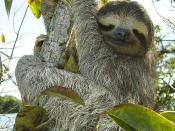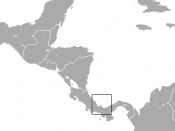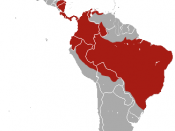The Brazilian three-toed sloth is a creature that is on the edge of becoming extinct. The Brazilian three-toed sloth is in the Mammalia class, an Endentata, its family is the Bradypodidae, its genus is Bradypus, and its species is the Bradypus variegatus. The Brazilian three-toed sloth is a slow moving creature due to its speed it has become an endangered species because predators can get to them easily. The sloth is the slowest moving mammal in the world. (www.enchantedlearning.com/subjects/mammals/sloth) Even though the sloth is incredibly slow moving it is surprisingly not a very big mammal. The sloth is only around two feet tall, which is about 420 to 800 millimeters tall. (www.123spot.com/animaldirectory/sloth3.html) It also weighs only around 3.6 to 4.2 kilograms. (www.endangeredlife.org) This is more than the normal three-toed sloth is which weigh usually quiet a bit less. The tail of the sloth is about 1 to 3 inches long.
(www.animalsoftherainforest.com/sloth.html) The Brazilian three-toed sloth has a brownish fur, which it uses to try and camouflage itself. Also, to try and help camouflage itself the sloth has lots of green algae on it so it blends better with the leaves in the trees. (www.kalama.doe.hawaii.edu/hern95/pt006/g4/c3/jeremyp.html) Due to the great camouflage on the sloth and its lack of movement the sloth becomes basically a living habitat for many insects in the rain forest. Insects such as beetles live in the fur of the sloth and feed off its algae. There is no real clue to how many of these poor creatures are still remaining due to it being so hard to count them. It is so hard to find them because they live in the Brazilian rain forest, which is a very large area that is very condensed with many different organisms.
The sloth has many problems due to its speed. The slowness of the sloth causes it to be easily hunted by its predators. The sloth's predators consist of the jaguar, ocelot, and anacondas. (www.kalama.doe.hawaii.edu/hern95/pt006/g4/c3/jeremyp.html) The jaguar and the ocelot are both very quick animals which is why the sloth doesn't try to get away instead when the sloth feels it needs to defend itself the sloth will become physical and begin to fight it's predator off it. The Brazilian three-toed sloth is also declining in population do due deforestation in its habitat. The Brazilian three-toed sloth lives along the Atlantic coastal forests in Brazil. This area is now becoming the most human habituated area of Brazil. Sloths are also declining because people are hunting them for food and medical purposes. (www.endangeredlife.org) The sloth's spends most of its time hanging upside down from trees. The sloth is a nocturnal animal. The sloth also sleeps for about eight-teen hours a day. (www.passporttoknowledge.com/rainforest/ecosystem/animals/3toedsloth.html) The sloths have also developed over time a way of using the bathroom. They have managed to hold their waste for almost a full week before having to dispose of it. (www.bss.sfsu.edu/geog/bholzman/courses/fall99projects/sloth.html) They do this because they are very slow and getting to water is very difficult to them so, by not moving they conserve water. Sloths do most everything upside down. The sloths move on branches upside down, they also sleep upside down, and they also give birth to their offspring upside down too. The female produces usually one offspring per year and when she gives birth to it she does it upside down. The normal life span of a sloth is ten to twenty years; predators assuming that the sloth keeps to a normal diet and is not kill this. Sloth's are herbivores. They eat mostly just leaves. The cecropia tree is one of the most common trees that they eat off. The food is separated into many different compartments in there stomach.
The Brazilian three-toed sloth is currently being helped. There are many conservation projects going on the rebuild the population of this incredible specie. There has been successful translocation of the sloths. (Pinder, 1996) The sloths can not live in captivity like most normal animals because they will not reproduce while under captivity. So, to deal with those sloths are only keep in semi-captivity, which means they are just monitored but not held at an environmental establishment.
The Brazilian three-toed sloth is an incredible creature. Much is being done to save these creatures but still more needs to happen. The area in which the sloths live must be taken care of better than they are. The land should also stop being cut down so that way the sloths have somewhere to live and try to reproduce their specie. The sloth hopefully with time will someday be back to a good population size.





